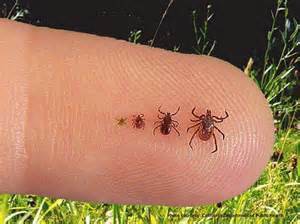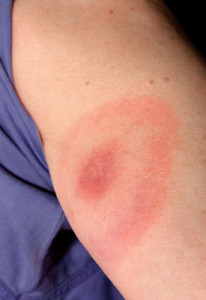 There is a lot of misinformation generated on social media about Lyme disease (Borrelia, Borreliosis) and other tick-borne illnesses. So, I thought it would be a good time to discuss some of the basics about Lyme disease and in the coming months I will cover some other areas. I have learned a great deal about all of this for personal and professional reasons. As a nutritionist and health educator, I see clients who have medical conditions as a result of chronic Lyme Disease.
There is a lot of misinformation generated on social media about Lyme disease (Borrelia, Borreliosis) and other tick-borne illnesses. So, I thought it would be a good time to discuss some of the basics about Lyme disease and in the coming months I will cover some other areas. I have learned a great deal about all of this for personal and professional reasons. As a nutritionist and health educator, I see clients who have medical conditions as a result of chronic Lyme Disease.
 Lyme disease is a pandemic, found all over our country and in other countries worldwide. Pennsylvania is one of the top states for Lyme disease. There are two schools of thought on Lyme disease and one is the Infectious Disease Society of America (IDSA) and the other the International Lyme and Associated Diseases Society (ILADS). IDSA does not appear to believe in chronic Lyme or treating beyond 4 weeks. ILADS is an international progressive organization that understands that Lyme and other associated pathogens are stealth and need combination antibiotic therapy that addresses each pathogen and longer than 4 weeks in chronic cases. If you suspect you have chronic Lyme disease in my opinion you definitely want to go to a Lyme Literate Medical Doctor or commonly known as a LLMD or a Lyme Literate Nurse Practitioner, not someone who doesn’t believe in chronic Lyme. Also, unfortunately many pediatricians and primary care doctors are not adequately trained on Lyme and related diseases. It is much easier to treat these diseases early on then to deal with chronic infections.
Lyme disease is a pandemic, found all over our country and in other countries worldwide. Pennsylvania is one of the top states for Lyme disease. There are two schools of thought on Lyme disease and one is the Infectious Disease Society of America (IDSA) and the other the International Lyme and Associated Diseases Society (ILADS). IDSA does not appear to believe in chronic Lyme or treating beyond 4 weeks. ILADS is an international progressive organization that understands that Lyme and other associated pathogens are stealth and need combination antibiotic therapy that addresses each pathogen and longer than 4 weeks in chronic cases. If you suspect you have chronic Lyme disease in my opinion you definitely want to go to a Lyme Literate Medical Doctor or commonly known as a LLMD or a Lyme Literate Nurse Practitioner, not someone who doesn’t believe in chronic Lyme. Also, unfortunately many pediatricians and primary care doctors are not adequately trained on Lyme and related diseases. It is much easier to treat these diseases early on then to deal with chronic infections.
 There are over 100 strains of Borrelia in the United States and over 300 world-wide. There are five subspecies of Borrelia Burgdorferi disease, but the one most well known is Borrelia Burgdorferi, named after Willy Burgdoerfer who identified the strain in 1982. Willy passed away in 2014. There is no safe amount of time for a tick to be attached. Ticks can transmit not only Lyme disease, but many other infections also known as co-infections such as babesia, bartonella, ehrlichia, Rocky Mountain spotted fever and more. The symptoms of the infections can overlap and testing for all of the infections is not that great and can be expensive. There are proper ways to remove a tick and if you do, you can also have the tick tested, information on this as well as good prevention strategies can be found on the Tick Encounter site by the University of Rhode Island.
There are over 100 strains of Borrelia in the United States and over 300 world-wide. There are five subspecies of Borrelia Burgdorferi disease, but the one most well known is Borrelia Burgdorferi, named after Willy Burgdoerfer who identified the strain in 1982. Willy passed away in 2014. There is no safe amount of time for a tick to be attached. Ticks can transmit not only Lyme disease, but many other infections also known as co-infections such as babesia, bartonella, ehrlichia, Rocky Mountain spotted fever and more. The symptoms of the infections can overlap and testing for all of the infections is not that great and can be expensive. There are proper ways to remove a tick and if you do, you can also have the tick tested, information on this as well as good prevention strategies can be found on the Tick Encounter site by the University of Rhode Island.
This year the media has reported in many states that Lyme disease is on the rise. Also, there are many celebrities have been public about having dealt with Lyme disease, most recently Yolanda Foster, Avril Lavigne, and singer Rob Thomas’s wife Marisol Thomas.
 In the last few years I have read numerous books, attended and presented talks at various Lyme disease support group meetings, and watched numerous videos. I have attended several Lyme focused conferences including, the International Lyme and Associated Diseases Society (ILADS) conference at Drexel University in 2015, the Pennsylvania Lyme Resource Network Patient Symposium in 2016 and last week I attended ILADS again here in Philadelphia. Last month, I gave a talk (the first ever Lyme talk to my knowledge) to at my professional at our annual meeting in Boston along with Dr. Garabedian of the Garabedian Clinic here in King of Prussia, PA.
In the last few years I have read numerous books, attended and presented talks at various Lyme disease support group meetings, and watched numerous videos. I have attended several Lyme focused conferences including, the International Lyme and Associated Diseases Society (ILADS) conference at Drexel University in 2015, the Pennsylvania Lyme Resource Network Patient Symposium in 2016 and last week I attended ILADS again here in Philadelphia. Last month, I gave a talk (the first ever Lyme talk to my knowledge) to at my professional at our annual meeting in Boston along with Dr. Garabedian of the Garabedian Clinic here in King of Prussia, PA.
 There are a lot of myths about Lyme disease and I have seen them over and over again in various social media forums. So, take some time to get educated on Lyme Disease if you haven’t and practice prevention. This could help you or a loved on. A few of the myths I have seen over and over are that a tick has to be attached for at least 24 hours to transmit Lyme, 2 weeks of antibiotics for a new tick bite is sufficient, if you don’t get a bull’s-eye then you can’t get Lyme, and that you can’t get Lyme in the winter. In fact, there is no safe amount of time for a tick to be attached, 2 weeks of antibiotics for a new bite is not sufficient, many LLMDs will prescribe 6-8 weeks or even longer, less than 50% remember a tick bite or have a bull’s-eye, and ticks have been known to survive during winter, especially with our global warming. Ticks inject an anesthetic so you can’t feel a bite.
There are a lot of myths about Lyme disease and I have seen them over and over again in various social media forums. So, take some time to get educated on Lyme Disease if you haven’t and practice prevention. This could help you or a loved on. A few of the myths I have seen over and over are that a tick has to be attached for at least 24 hours to transmit Lyme, 2 weeks of antibiotics for a new tick bite is sufficient, if you don’t get a bull’s-eye then you can’t get Lyme, and that you can’t get Lyme in the winter. In fact, there is no safe amount of time for a tick to be attached, 2 weeks of antibiotics for a new bite is not sufficient, many LLMDs will prescribe 6-8 weeks or even longer, less than 50% remember a tick bite or have a bull’s-eye, and ticks have been known to survive during winter, especially with our global warming. Ticks inject an anesthetic so you can’t feel a bite.

Lyme Disease Advocate & Friend Amy Tiehel
ILADS has a lot of great information on their website including, Basic Information About Lyme Disease, Top Ten Tips to Prevent Chronic Lyme Disease, and Lyme Disease Guidelines. I have put together a Lyme Disease & Biotoxin Resources page on our website that has links to how to find a LLMD, Books, Blogs, Support Groups, and more. If you think you may have chronic Lyme, you can fill out this symptom list by Dr. Horowitz and seek out a LLMD. If you are in Pennsylvania, the Pennsylvania Lyme Resource Network is a great resource!